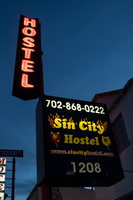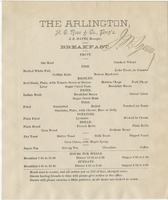Search the Special Collections and Archives Portal
Search Results
Clyde F. Merrick Photographic Slides
Identifier
Abstract
The Clyde F. Merrick Photographic Slides (approximately 1971-1979) contain color photographic slides taken by Clyde F. Merrick, longtime resident of Las Vegas, Nevada. The majority of slides in this collection depict signs for different businesses around Las Vegas including the Las Vegas Strip and the Westside. Some of the businesses documented in this collection includes Fong's Garden, Leon's Shear Magic Beauty Salon, Lucas and Son's Antiques, Dick's Tricky Trikes, Mohan's Custom Tailors, the Twenty Grand Club, Owens TV Repair, and Caesars Palace. The collection also documents a variety of different types of businesses around Las Vegas including bars and nightclubs, beauty salons, car washes, gas stations, and restaurants. Merrick was also a car racing hobbyist and a number of slides in this collection depict what is presumed to be the Las Vegas Speedrome racetrack (later known the Las Vegas Motor Speedway). This collection also includes photographs of locations outside of Las Vegas and Southern Nevada.
Archival Collection
William Flangas Scrapbooks
Identifier
Abstract
The William Flangas Srapbooks document his anti-smoking efforts in Nevada from 1974 to 2014. These materials include correspondence, articles, copies of assembly bills, newsletters related to smoking and health, and newsletters related to non-smokers.
Archival Collection
Kenneth Giles Professional Papers
Identifier
Abstract
The Kenneth Giles Professional Papers (1964-2001) contain documents and visual material related to Giles's time as an Environmental Radiation Monitor for the Environmental Protection Agency (EPA) at the Nevada Test Site (NTS). Photographic slides, film, and digital images depict the general flora and fauna throughout the area surrounding the NTS. Visual materials also document specific mule deer and steer surveillance and testing at the EPA Farm located within the NTS. The collection also contains environmental reports written or collected by Giles, government documents, pamphlets, and newspaper clippings related to environmental monitoring and Giles's work at NTS. A small portion of the collection documents his brief role providing monitoring support at Three Mile Island in Pennsylvania in 1979. Note: Some images may be of a graphic or disturbing nature and may not be suitable for some users. Photographs may contain scenes of animal testing or other objectionable imagery.
Archival Collection
Archie and Zora Grant Papers
Identifier
Abstract
The Archie and Zora Grant Papers document the lives of Archie and Zora Grant from 1918 to 1973. Materials include scrapbooks, clippings, correspondence, records, certificates, and awards pertaining to Archie’s career in the Nevada Legislature, the State Board of Education, Las Vegas Housing Authority, and Las Vegas Chamber of Commerce.
Archival Collection
Eileen Brookman Papers
Identifier
Abstract
The Eileen Brookman Papers date from 1934 to 2002 and document Brookman's personal life and political career. Brookman was active in the Las Vegas Jewish community. Personal papers include programs from B'nai B'rith, scrapbook materials, correspondence, and photographs. The collection includes documentation from the White House Conference on Aging. She served several terms in the Nevada State Assembly from 1967 to 1977 and again from 1987 to 1989. Political materials include legislative information, bumper stickers, election returns, and newspaper clippings.
Archival Collection
Stella Champo Iaconis oral history interviews
Identifier
Abstract
Oral history interview with Stella Champo Iaconis conducted by Kay Long on May 14, 1997, May 21, 1997, May 26, 1997, and September 22, 1997 for the Women's Research Institute of Nevada (WRIN) Las Vegas Women Oral History Project. Iaconis opens her interviews discussing her difficult upbringing and life on a ranch in Las Vegas, Nevada with her dad in the 1910s and 1920s. Iaconis then describes her experiences as a waitress in Las Vegas. As the interviews continue, Iaconis discusses Block 16 and sex work, the Helldorado Days, and life in 1930s Las Vegas. Iaconis ends the interview talking about her father and his career as a miner; her many husbands; and her personal history in Las Vegas.
Archival Collection

Erica Mosca oral history interview: transcript
Date
Archival Collection
Description
Oral history interview with Erica Mosca conducted by Cecilia Winchell, Stefani Evans, and Jerwin Tiu on February 3, 2023 for the Reflections: the Las Vegas Asian American and Pacific Islander Oral History Project. In this interview, Mosca reflects on her life journey from a low-income Asian American to a current serving Nevada State Assemblywoman. She recalls that most of her childhood was in Palm Springs, California where she enjoyed a diverse community of students within her education system. It was not until she moved to Navato, California where she first experienced the economic and resource gap between economically diverse areas. Mosca went on to be involved in a college readiness program and received a scholarship to Boston University. After college, Mosca went on to work for Teach for America where she was stationed on the east side of Las Vegas at Goldfarb Elementary School where she grew a passion for leadership. She eventually returned to school and graduated from Harvard University, returning to Las Vegas to start her nonprofit "Leaders in Training." Mosca hopes to inspire change in her communities by enacting legislation and initiatives targeted towards the communities she was and continutes to be a part of.
Text

Film strip of individuals or Hoover Dam construction, image 006: photographic print
Date
Archival Collection
Description
Image

neo000139-004
Description
Notes: The logo cabinets which adorn the entrances on the elevated walkways: The letters start with both rows of text in the off position. The top row flashes on, while the bottom row is dark then the bottom row illuminates, as the top row goes dark. Once the top row flashes off it flashes back on so that both rows of text are briefly illuminated simultaneously before they both go dark and the sequence stars over again. While this is going on the incandescent bulbs which line all of the raceways are chasing each other from left to right on the horizontal planes, while the arched sections chase each other downward. The triangular peaks which radiate around the top of the logo sign, flash on and off in a sequence which chase each other downward. First the top center peak flashes on, then the next sequential triangular channel on both sides illuminate simultaneously, flash off, then the next two in the series illuminate. The resultant effect is a chasing pattern starting from the top. The sister animation is located on almost the exact same design on the porte cochere. I would think the previous smaller sign would be based on the larger porte cochere. The other variance besides obvious size difference is the that the channel letters are filled with incandescent bulbs instead of neon. The animation is a bit simpler as well. The incandescent bulbs oscillate continuously while the triangular pan channels which create the radiating crown, animate. The neon in the channels chase each other as described in the smaller walk way version, while the text continues until the entire text flashes off, then on, off, then begin to animate once again. All of the bulbs, which line the raceways of the exterior edge of the porte cochere, as well as the encrustation of bulbs on the brass bull nose portion, animate in rapid succession. All the raceway bulbs chase each other while the bulbs on the brass portion continually oscillate. Animation continues on the east face of the building with the entrances first. The principle for these two signs is oscillation and chasing. All bulbs on the underside of the entrance, as well as in the logo, oscillate rapidly. All bulbs on the raceways chase each other. Further on the surface of the building as well, the Pepsi cola wall sign is found displaying a very unique form of animation, seen here on the strip. The signage for the Pepsi ad is located on the eastern wall. (Detailed in specific description) The Incandescent bulbs which fill the inside of the text that spells Pepsi, chase each other from left to right, leaving all the bulbs in its path illuminated, as if writing out the word Pepsi. The neon bars located within the tilted bottle of Pepsi are illuminated, and chase each other downward, leaving the bars it its path dark. As this sequence in taking place, the waving tubes of neon illuminate, flashed subtly making the neon appear as soda pouring out of the bottle. As the tubing flows then the vertical neon bars in the cup illuminate one at a time making the cup appear as if it is filling up. The text above each of the painted fires head, flashes back and forth as if talking to each other as well. ESPN ZONE animation: The letters in the vertical blade portion of the ESPN Zone illuminate one at a time, starting from the top. Once the entire phrase is lit, in flashes off then on then off, before restating. The orange and red neon tubing which resides inside the pan channels that represent flames flash on and off in a relaxed manner as if to animate the flickering of the flames. The small incandescent bulbs on the black portions above the main matrix reader board flash on and off subtly.
Sign keywords: Neon; Backlit

The Arlington, breakfast menu
Date
Archival Collection
Description
Text
